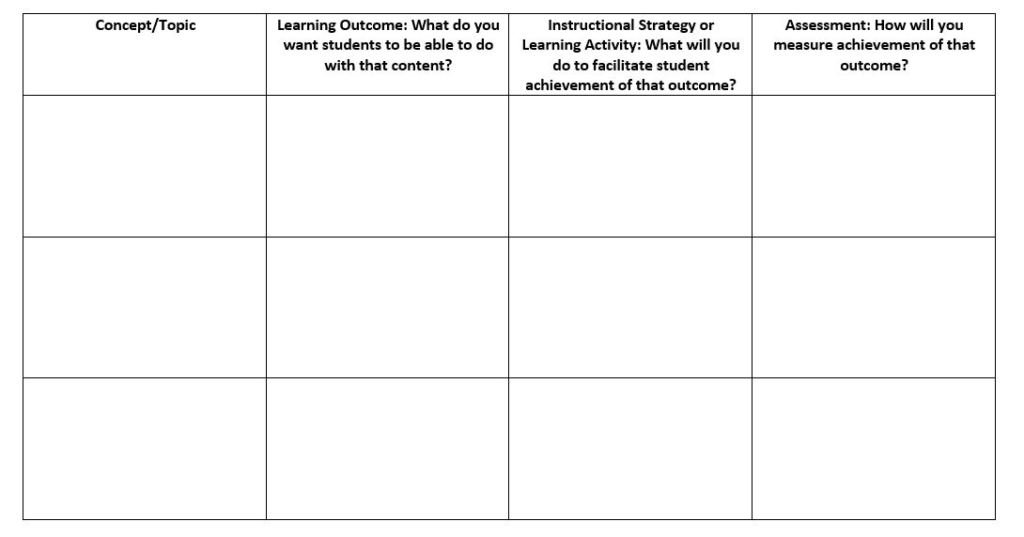Here’s a brief look at how constructive alignment works. Click on the hotspots to learn more!
Course-level learning outcomes (CLOs) allow instructors and programs to communicate what skills, knowledge, and attitudes students should have acquired by the end of a course. CLOs are essential to help students understand what their learning will be–and what successful demonstration of that learning will look like. They also provide information about what learning will be assessed. For example, “By the end of the course, students will be able to document research resources using APA format.”
CLOs assist students in achieving transfer credit for specific courses if they wish to move to another post-secondary institution, as those determining course equivalencies often rely on the CLOs for comparison.
How many CLOs are enough? How many are too many? There are many opinions about this, but there is no single right answer. This will depend on how detailed your CLOs are. As already mentioned, if your outcomes are too big and broad, they will be difficult to evaluate, but if they are too detailed, you’ll limit flexibility (MacEwan Faculty Commons, 2012). A good range is 5-7 per course, but sometimes you may need more or fewer. If you find your course has only 2 or 3 CLOs, you may wish to break them down a bit further into sub-outcomes.If you find your course has 12 or more, it’s likely they are too detailed, which may limit instructor flexibility.
CLOs should align with program-level learning outcomes (PLOs) in order for programs to be able to ensure students leave with the skills, knowledge, and attitudes necessary for graduates to be successful in their chosen paths. However, constructive curricular alignment within a course is also essential. CLOs should drive content delivery, instructional strategies and learning activities, course materials, and assessment activities.
The graphic below depicts how constructive curricular alignment works within a course:
In order to plan a course that is aligned, you may find the following planning table helpful. In the first column, list your main course topics, ideally one per box. In the second column, fill in the course learning outcomes/educational objectives that align with the content in the first column. Ensure that the content matches or aligns with the outcome. In the third column, list the activities you’ve planned to ensure students achieve the outcomes/objectives in the second column. The assessments, whether formative or summative, should help you determine whether students have achieved the outcomes/objectives in the second column. Please outline these in the final column. You can download a copy of the table by clicking here: link to course planning table.

Program-level learning outcomes (PLOs) allow programs to articulate what skills, competencies, capabilities, knowledge, and attitudes learners are expected to attain upon completion of a program. A set of well-designed PLOs will describe what a School/Faculty/Program aims to accomplish by offering their particular degree to prospective students and what skills, knowledge, and attitudes, specifically, the School/Faculty/Program believes that graduates of the program will have attained upon completion of the program. The PLOs need to be concise descriptions of the impact the program will have on its successful students.
PLOs should align with institutional level learning outcomes (ILOs) in order for the institution to be able to ensure students leave with the skills, knowledge, and attitudes necessary for graduates to be successful in their chosen paths.
Creating PLOs follows the same process as creating CLOs with the same formula:
Action Verb + Object/Content Area + Qualifying Phrase Indicating Conditions or Criteria
For example, By the end of this program, learners should be able to “Critique tourism practices for their implications locally and globally” (BTM PLOs, 2017).
Institutional-level learning outcomes (ILOs) allow institutions to articulate what skills, competencies, capabilities, knowledge, and attitudes students should have attained upon completion of a baccalaureate credential.
A set of well-designed ILOs will describe what a Post Secondary Institution aims to accomplish by offering their baccalaureate degrees to prospective students and what specifically the Institution believes that graduates will have attained upon graduation. The institution-level learning outcomes need to be concise descriptions of the impact on its students by the time the students graduate with their baccalaureate degree. These are similar to Graduate Learning Outcomes in the literature. ILOs are designed by mapping to program and course level learning outcomes to ensure all the ILOs have been included at every level of a students’ education.
For example, Thompson Rivers University (TRU) has developed eight ILOs to which programs are currently mapping their PLOs: For example,
“A TRU graduate should be able to demonstrate effective communication skills appropriate to a range of audiences and contexts” (TRU ILOs).
The full list is available here; each also has additional descriptions of what the outcome means.
TRU has its ILOs located at https://www.tru.ca/current/enrolment-services/course-registration/institutional-learning-outcomes.html
TRU’s ILOs
Based on broad input from faculty, staff, alumni, and students, the University Senate approved the existing institutional learning outcomes.
TRU took a bottom-up approach to general education by ensuring faculty lead the identification of general education courses based upon set criteria. The Academic Planning & Priorities Committee of Senate has directed the General Education Taskforce (GET) to facilitate the implementation process in collaboration with faculties and schools. TRU took existing graduate attributes and used them as the basis for their ILOs.
TRU researched various models for General Education across Canada, chose a model, and now drafting the logistics of a GE program for TRU. There was a refining of the ILOs based on feedback and drafting descriptions from the GET survey to Faculty and Faculty councils.

